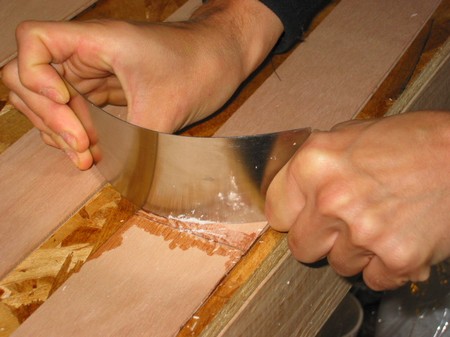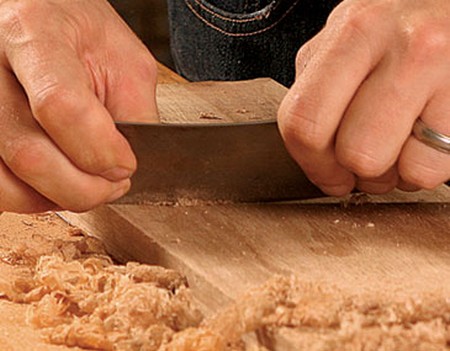A favourite finisher’s tool, the cabinet scraper is merely a rectangular piece of tool steel which can take four sharp edges. It will produce a smooth cut, however wild the grain is, which is why it is indispensable for work on veneers with decorative, curly grain. To use the scraper, hold it in both hands, with your thumbs in the middle, flexing it and pushing away from you at a 45° angle to the surface. It should produce a shaving and leave a very smooth surface. If you get dust, it is blunt; if the grain cuts up rough, push it the other way. It can heat up very quickly and burn your thumbs, so take a slight warmth as a warning.

To sharpen the scraper, the thin edge must be dead square to the flat face, and dead straight. Hold it in a vice (vise) and draw a flat file along the edge to get the right angle. You have to produce a burr and wipe (curl) it back – it is the burr itself that cuts. Draw the edge back and forth on an oilstone, keeping it absolutely square to the stone, or trap it between the two halves of the box and rub on the stone’s edge, if you have one in a box. When you feel a burr on both sides of the edge, lay it flat on the bench and strop it with a round piece of spring steel or the back of a gouge (the ticketter/ burnisher). This brings the burr over in line with the flat face, so the ticketter must be flat to that face. Now hold the scraper on end on the bench and pad your hand with a cloth. Run the ticketter up the narrow edge, angling it back towards the flat face very slightly. Do this three or four times on all the corners, angling the ticketter back slightly more each time till it is at about 70°-80° to the flat. Try the cut; if you get dust not shavings, take it back to the stone.

Old finishes are hard, and will blunt this burr quite quickly. The last two ticketter stages will ‘dress’ the cutting edge again, but after three or four times, you will need to take it back to the stone.